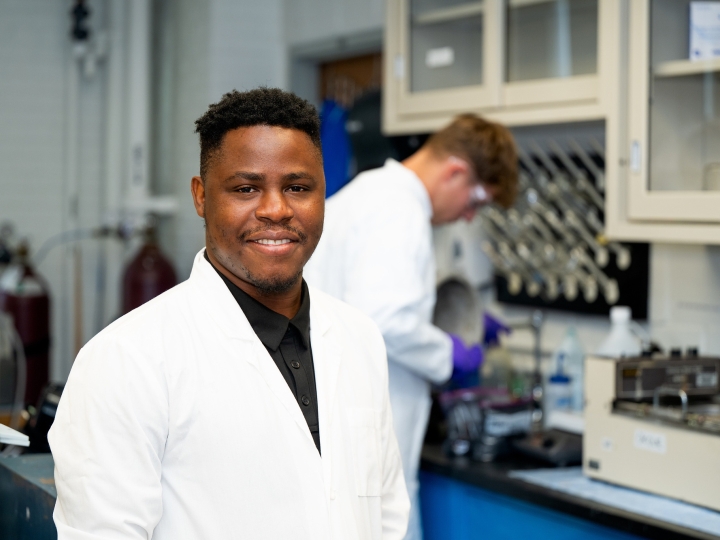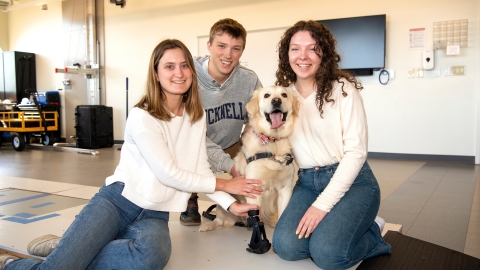
Bucknell Engineers Build Prosthetic Leg for Adopted Dog
May 17, 2023
Emma O'Shea '23, Will Carcieri '23 and Grace Adams '23 designed and crafted a prosthetic leg for Doug, a three-legged golden retriever.
Mary Ann Stanton '89 first met Doug, a three-legged golden retriever, when her daughter offered to dog sit the two-year-old, high-energy pup. It was going to be a temporary arrangement, but when Doug's family could no longer care for him, Stanton's family offered him a permanent home.
Because Doug was born with his disability, he was comfortable getting around on just three legs. Though he doesn't currently have mobility issues, Stanton's veterinarian said Doug could eventually develop severe arthritis in his front weight-bearing leg, and that a prosthetic could offer relief and keep his left leg healthy.
As a Bucknell alum and employee — Stanton is the University's director of development, strategic philanthropy programs, education & corporate, foundation and government relations — she knew where to turn: the College of Engineering. Three students — Grace Adams '23, biomedical engineering; Will Carcieri '23, mechanical engineering; and Emma O'Shea '23, biomedical engineering — were eager to take on the pet project.
Adams, Carcieri and O'Shea are members of e-Nable, a national organization that creates 3D-printed prosthetics free of charge for those who need them. Carcieri and O'Shea, who are co-presidents of Bucknell's e-Nable chapter, say they usually create human hand, arm and finger prosthetics — so designing a canine leg has presented unique challenges.
"One obstacle we have been working around is keeping the prosthetic on his leg," O'Shea says. "We are playing around with a harness and velcro straps, but when he moves and runs, the tension changes."
The team has worked through different materials and modifications, adding foam for comfort and testing different attachments to achieve the best results. Their biggest challenge thus far has been getting Doug to want to wear the prosthetic since he is so well-adjusted to life without a fourth leg.
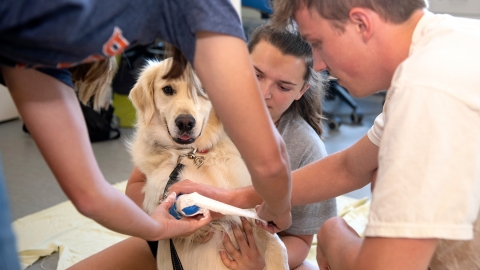
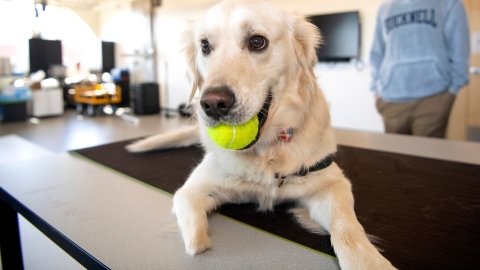
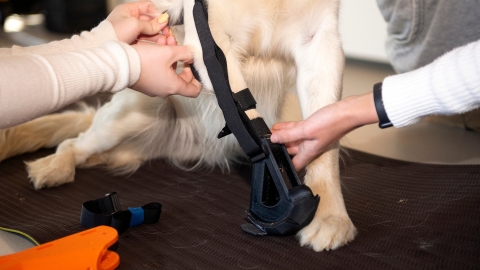
"For this to be successful, the biggest thing is to make it comfortable so Doug will want to wear it," Adams says. "The prosthetic will be challenging for Doug to adapt to," Stanton says, "but in the long run, it will hopefully lengthen and make his quality of life better."
Discovering the most functional prosthetic design has been a process of trial and error. The team began with digital CAD models, which were then 3D printed in Academic East.
After testing different 3D-printed prototypes, the students transitioned to a modeled prosthetic created with a plaster mold. By initially experimenting with 3D-printed models, the final prosthetic will have a more accurate and comfortable fit.
Throughout the project, the students have found their subject to be the model patient. "It has been great getting to work with Doug," O'Shea says. "He is so happy and playful, which brightens our days. It is incredibly rewarding to try to help such a great dog."
The seniors worked to improve the prosthetic's comfort and functionality through the end of the academic year. Their efforts open the door for future students to make adaptations to keep up with Doug — and potentially aid other pets with similar health conditions.
